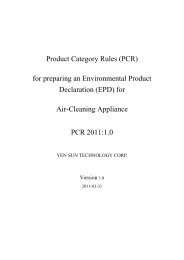Download(PDF) - PCR Library
Download(PDF) - PCR Library
Download(PDF) - PCR Library
You also want an ePaper? Increase the reach of your titles
YUMPU automatically turns print PDFs into web optimized ePapers that Google loves.
All data has to be specified and it shall include the database and year of publication (reference).<br />
Sources of data for transport models (including transport form, distances and quantities to be<br />
transported) and thermal energy production shall be documented.<br />
7 Additional information<br />
Relevant information, such as specific manufacturing processes, beneficial from the<br />
environmental point of view can be described. Technical data that is needed to model the<br />
building stage e.g. load requirements etc. A description of toxicity effects, occurring in the use of<br />
the product, e.g. in processes such as leaching, shall be given.<br />
The specified rules in the previous sections secures that all relevant environmental impact<br />
information will be documented in the EPD report.<br />
7.1 Chemicals (voluntary)<br />
Other information that can be represented in the EPD is specification of materials and substances<br />
that can adversely affect the environment, human health and the indoor environment in all stages<br />
of the life cycle.<br />
A detailed list of the product’s substances (chemicals used in manufacture), including<br />
identification number and hazard class, can be included in the product content declaration. The<br />
content of substances shall be declared in weight %. In those cases where information of content<br />
could affect patent or business secrets, a qualitative list of chemicals and their expected impacts<br />
will be sufficient.<br />
7.1.1 Health risk impact (voluntary)<br />
The health risk impacts can be calculated according to the rules developed in the project<br />
“Environmental Product Declaration (EPD) as a tool for documentation/information on chemicals<br />
and toxicity in the value chains of products – a pre-study for EPD-Norway”. The calculation<br />
methods for calculating the health risk impact and environmental impact are described in<br />
Appendix 2 and the results are classified in 6 classes.<br />
Since the working environment is not included in ISO 21930: 2007 “Environmental declaration<br />
of building products”, the working environment will not be included in the EPD for building<br />
materials. Such calculation may be carried out in the company’s Environmental Management<br />
System. The working environment is normally a subject for national legislation.<br />
7.2 Indoor environment impact<br />
Impact on the indoor environment (inneklima) may be classified according to the M1 method.<br />
The calculation method for calculating indoor environmental impact is described in Appendix 3.<br />
N<strong>PCR</strong> 014 Windows and doors April 2009 side 11 av 17















